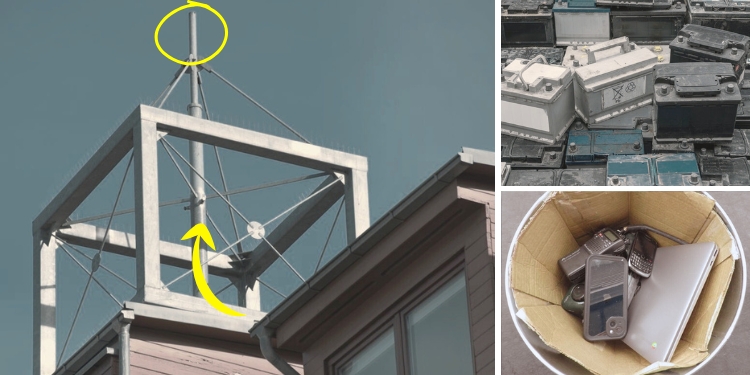Faraday cages have long been touted as the ultimate solution for protecting your electronics from electromagnetic pulse (EMP) attacks. The idea of having a simple enclosure that can shield sensitive devices from potentially catastrophic EMPs is undeniably appealing, especially in a world where technology is so vital to daily life. But while Faraday cages can offer valuable protection, there are several downsides that few people discuss. Understanding these limitations is crucial if you’re relying on a Faraday cage as part of your survival plan.
False Sense of Security
One of the biggest risks of having a Faraday cage is the false sense of security it can create. Many people believe that as long as their electronics are stored inside a Faraday cage, they’re completely safe from EMPs. However, not all Faraday cages are created equal. The effectiveness of a Faraday cage depends on several factors, including the materials used, the construction quality, and the type of EMP or electromagnetic interference (EMI) it’s trying to block.
Related: 15 Things You Think You Know About Faraday Cages But You Don’t
Not all metals are equally effective at blocking electromagnetic waves. While aluminum foil might work for smaller-scale protection, it’s not as reliable as high-quality conductive materials like copper mesh. If the cage isn’t made from the right materials, it may fail to shield your devices adequately. And even if you have the right materials, a tiny gap or flaw in the construction—like a poorly fitted door or an unsealed seam—can render a Faraday cage ineffective. It’s essential to regularly inspect your cage for any weaknesses or wear that could compromise its protective ability.
Limited Capacity and Accessibility
 Faraday cages are only as effective as what they can contain, and their limited space can be a major drawback. Many Faraday cages are small boxes or storage bins, which means you can only fit a limited number of items inside. If you have several critical devices to protect—like radios, laptops, solar chargers, and medical equipment—you may find yourself struggling to fit everything in. In an emergency, you might be forced to make tough decisions about which items are most essential, and that can be a stressful choice when time is of the essence.
Faraday cages are only as effective as what they can contain, and their limited space can be a major drawback. Many Faraday cages are small boxes or storage bins, which means you can only fit a limited number of items inside. If you have several critical devices to protect—like radios, laptops, solar chargers, and medical equipment—you may find yourself struggling to fit everything in. In an emergency, you might be forced to make tough decisions about which items are most essential, and that can be a stressful choice when time is of the essence.
Accessibility is another issue. Faraday cages are designed to be sealed to prevent electromagnetic waves from getting inside, which means that once your devices are in there, they aren’t easily accessible. If an emergency strikes and you need your electronics quickly, you might find it cumbersome and time-consuming to access and reseal your Faraday cage. This limitation means you’ll need to strike a balance between keeping your devices protected and having them ready for use when you need them most.
Incomplete Protection
Faraday cages are not infallible—they can offer significant protection, but they aren’t a guarantee. For optimal performance, a Faraday cage should be properly grounded. However, not all pre-made Faraday cages come with grounding options, and many people overlook this critical step when constructing their own. A poorly grounded Faraday cage may provide only partial shielding, reducing its effectiveness.
Even with the best construction, some EMPs are so powerful that they might still partially penetrate a Faraday cage. A high-altitude nuclear EMP (HEMP), for instance, can generate a massive burst of energy that could overwhelm even well-built cages if they’re not constructed to military-grade specifications. It’s important to understand that while a Faraday cage can reduce the risk of damage, it might not completely eliminate it.
Practical Limitations in Real-Life Scenarios
While a Faraday cage might work well in theory, real-life scenarios can present practical challenges that diminish its effectiveness. Many of us use our electronics frequently, which means that they’re often outside the Faraday cage. For the cage to provide protection, the devices need to be inside when the EMP occurs—which requires constant vigilance and disciplined usage habits. This can be difficult to maintain, especially if the electronics in question are part of your daily routine.
Battery degradation is another factor to consider. Electronics stored in a Faraday cage for long periods may face issues with battery life. By the time you need them, the batteries might be drained or damaged, rendering the devices useless. It’s important to periodically check and maintain your electronics, which means opening and resealing your Faraday cage regularly. This ongoing maintenance can be cumbersome and may lead to gaps in protection if not done consistently.
Since there are so many limitations, it is a very good idea to also get an EMP Cloth for your smaller electronics. At 15 feet long by 3.5 feet wide, the cloth can offer protection similar to a Faraday Cage to any portable generator. Ica can also be sewed to another EMP cloth to protect larger items, like your car. For only $79 you can gain an extra protection layer for your smaller items like a cellphone or even your key fob.
Just make sure to hurry since EMP cloths go fast due to extreme popularity among preppers. See if there is still one available for you here.
Cost and Effort
Building an effective Faraday cage isn’t as simple or cheap as some might think. High-quality materials like copper mesh, galvanized steel, or specialized conductive fabric can be expensive, especially if you’re planning on constructing a larger cage. Cutting corners with cheaper materials can compromise the protection level, making all your efforts go to waste.
Related: 5-Minutes DIY Tested Faraday Cage Out Of A Trash Can
Proper construction also takes time, effort, and often a level of technical expertise that many people don’t have. It’s not just about wrapping your electronics in foil—an effective Faraday cage requires careful design to ensure there are no gaps or weak points that could let EMP energy penetrate. For many, the cost and effort involved in building a truly reliable Faraday cage can be a major obstacle.
Not a One-Size-Fits-All Solution
 A Faraday cage is an important tool, but it should be seen as part of a broader survival strategy—not the ultimate answer to EMP preparedness. Even if your electronics are safely stored, a larger EMP event could still knock out power grids, communication infrastructure, and other critical systems, leaving you with functioning electronics but no power source or connectivity. Solar panels and other renewable power sources might also be at risk unless they are similarly protected, making it difficult to recharge devices after an EMP.
A Faraday cage is an important tool, but it should be seen as part of a broader survival strategy—not the ultimate answer to EMP preparedness. Even if your electronics are safely stored, a larger EMP event could still knock out power grids, communication infrastructure, and other critical systems, leaving you with functioning electronics but no power source or connectivity. Solar panels and other renewable power sources might also be at risk unless they are similarly protected, making it difficult to recharge devices after an EMP.
Additionally, having a functioning radio or laptop after an EMP won’t help much if you don’t know how to use it effectively in a grid-down scenario. EMP protection needs to go hand-in-hand with off-grid skills, securing alternative power sources, and building a resilient lifestyle. Relying solely on a Faraday cage can leave you vulnerable if you haven’t taken other critical steps to prepare for life without modern conveniences.
Final Thoughts
Faraday cages are a valuable tool for protecting sensitive electronics from EMPs, but they come with their downsides. They require careful construction, proper materials, and ongoing maintenance to be effective. Limited capacity, accessibility challenges, and practical limitations in real-life scenarios mean that they should not be relied upon as a foolproof solution. Instead, think of your Faraday cage as one piece of a larger preparedness puzzle—one that includes alternative communication methods, power generation options, and the skills necessary to thrive in a post-EMP world.
Understanding the potential downsides of using a Faraday cage will help you make better, more informed decisions about your survival strategy. Stay prepared, stay informed, and remember that true resilience comes from adaptability and knowledge, not just from technology.
You may also like:
10 Faraday Cages You Can Make at Home
The Only Way to Communicate After an EMP (Video)
How To Build The Poor Man’s Faraday Cage
















Great article , Great ideas on this subject
Truth be know :
A Cage is a form of separation and isolation from surrounding effects in environment’s or outside forces
To be effective their must be proper Isolation
Proper bond of surrounding areas to make Shure the incoming pulse will be properly grounded with out effecting the isolated environment , this means you cannot just put a cover over something and have it work properly
Shielding protects from incoming static or discharge
grounding and bonding makes sure static or discharge goes somewhere besides into the item being protected
since EMP is a Pulse or wave form , it is not repetitive , when the discharge or wave hits it will deplete and go to earth ground True Ground
This is why Grounds, Bonds are so critical to this article
As an expert in these fields I have spent over 40 years in this field
and any type of shielding hast to be Right or failure is imminent
Research, Real Education and Proper application
As said in past only two forces at work : God, Good , Structure, vs , Evil , bad, koas,
Truth Needs NO Defense , it will always Prevail and show the evil around us .
Plan, Prepare, Educate and Apply so YOUR not left behind when this happens
I was working at a construction site years ago where an excavator pulled up an underground 10,000v line. The machine was charged but the roll cage acted as a Faraday cage and the operator remained seated and wasn’t hurt. A Faraday cage doesn’t have to be solid, when charged the current remains on the outside. So how is the EMP1 pulse different from other charge sources? Seems like the EMP Faraday cage is more of an insulator and maybe it is just terminology that is confusing me.
How do you ground a Faraday cage?
What ever you do, remember to bury it at least 3–4 feet from the top, this will ensure protection.
D.O.D & universities already did conduct these types of tests and found burying something under dirt provided the best protection, including the concussion from the blast.
I had a Faraday I made from a small metal ash can with lid. I have it lined with thick cardboard, even the lid, Everything I have in it is also inside a static resistance bag. My one question is; are AAA, AA, and D size batteries have to be inside of the cage or are they safe to be stored else where?
Normal batteries are generally immune to EMP.
The rechargeable Lithium Ion and similar are not due to electronics built into the battery.
Lead Acid batteries are also immune.
Reason – no electronics in them.
I store all my batteries in a battery storage container that is made of hard plastic that holds my AA/AAA/C/D size batteries. All of my rechargeable batteries and there charging stations are kept in another container that is made of metal lined with a thick cardboard liner, similar to a metal ammo box. Charging stations may have computer chip or something that indicates what level the batteries are at and when they are fully charged. Batteries for my radios, drills, Ego yard eqipment and etc… Keeping them charged is nesseccary and being in the lined ammo box makes easy access for this process.
I am a induvial, small framer. My e-mail is dennisrbuckley@yahoo.com
I have contacted Click Bank And they have no listing for this ad ?? My
intent is to buy 48 of these Faraday Blankets, to line a storage shed and
turn it into a Big Faraday Container.
I want 48 of those blankets and don’t care about the free books.
Please contact me , I have pre approved the money with Capital One,
enough to pay for the blankets, I think. Contact my e-mail….
Remember to that a microwave oven is a faraday cage. Counter top models can be had inexpensively at garage sales, thrift stores, etc. Emergency radios and walkie talkies and other small electronics fit easily.
I tested the microwave theory. It does NOT work.
Phone still rings while inside.
You’re right. A microwave is shielded for microwave energy from within. Even the glass window on a microwave has glaze material on it, to keep the energy inside. An EMP pulse is different. Not only does it come from outside, but it also has a different frequency and intensity, same as radio and communication frequencies.
Lead Laminated Drywall used in hospital x-ray room and CT Scan machine. $350 and up. very heavy. some places you can buy just the lead sheet. since i’ve installed i keep the extra lead for my DIY’s fish weights, ammo, faraday box, chrome plating, cast toys…
My general consensus is that if there is a true EMP, that there probably wont be any power on the grid, let alone internet… My PC and my laptop will probably be rendered useless…Now my commo gear is another story, I do have protection for that… I have NO digital downloads pertaining to prepping/survival… All my references and educational stuff are in printed form, no need for power, infact I refuse to purchase digital info on these type of subjects, put it in printed form, and I’ve probably already got it in my library… My important electronics excluding my already protected commo gear, will be like DVD players, small LED TV’s, and my collection of over 600 DVDs purely for entertainment… with several info type DVD’s… Residing where I reside I’ve learn how to live without the grid as it does go down, and usually can for 5+days or so… I should’ve stated that I live rurally, I escaped the Mega Metromess’s over 2 yrs ago.. But still, this article contains some fairly good information, I enjoy reading the articles almost as much as I do reading the comments, both are very entertaining, to say the least, Live long and prosper…
Reply to L.E.May: An EMP is an ElecroMagnetic Pulse, not unlike a radio wave or a wave of energy coming from a nuclear explosion. Standard insulation will not protect you from an EMP, just like a faraday cage will not protect you from sticking your finger into a light socket. A faraday cage captures the wave or the pulse and channels it, keeping it away from the items inside, and if grounded takes it to earth. Items inside the faraday cage, if made of metal, such as a laptop with a shiny tungsten body, also need to be insulated from the mesh or other metallic stuff the cage is made out of, if not , the charge will travel into the item and destroy the electronics. There are other variables, such as the size of the wave lengths compared to the size of the holes in the mesh; but small waves do not travel very far, only large waves can travel large distances, and the mesh sold from outlets are suitable for the types of waves we are protecting against.
This article is a good reminder and has sparked a few quetions. I have two steel 55 gallon drums that contain extra items that are bigger than a breadbox. These two barrels are stored in my 10X16 shed that is grounded. I’d like to ground these two barrels to the shed grounding rod that is on the inside of the shed. What is a recommendation on how to make this grounding connection to each barrel?
Second item on grounding: I have many smal containers that contain smaller items. Using the metal can that once contained cookies from Costco. Lined with thick cardboard. Yes, they work well. Tested them with my cell phone and portableable radios of various sizes. Example: one contains Medical equipment like blood pressuse, pulse oximeter, hearing aids, diabetic testing monitor, CPAP machine, defibrillator, and etc. Question how would you recommend on grounding these container? Many of these containers are stored in a spare bedroom along with other prepper items such a other medical supplies and 5 gallon bucket of mylar sealed dry foods such as rice and beans.
funny you should mention Hospitals
I work on MRI s in a different tasking area
They Lift units , Isolate , completely line all walls, ceilings, floors with Copper sheets , shielding 1/32 ” thick and have isolation filters for anything coming into unit.
Typical of Faraday cage
Buy sheets of copper in rolls , then solder all seems and you will have the cage
Same principle : look up Frequency’s of EMP and MW , Cellular, and other items and you will see
What Frequency and what wavelength , what you need is total isolation , not covering